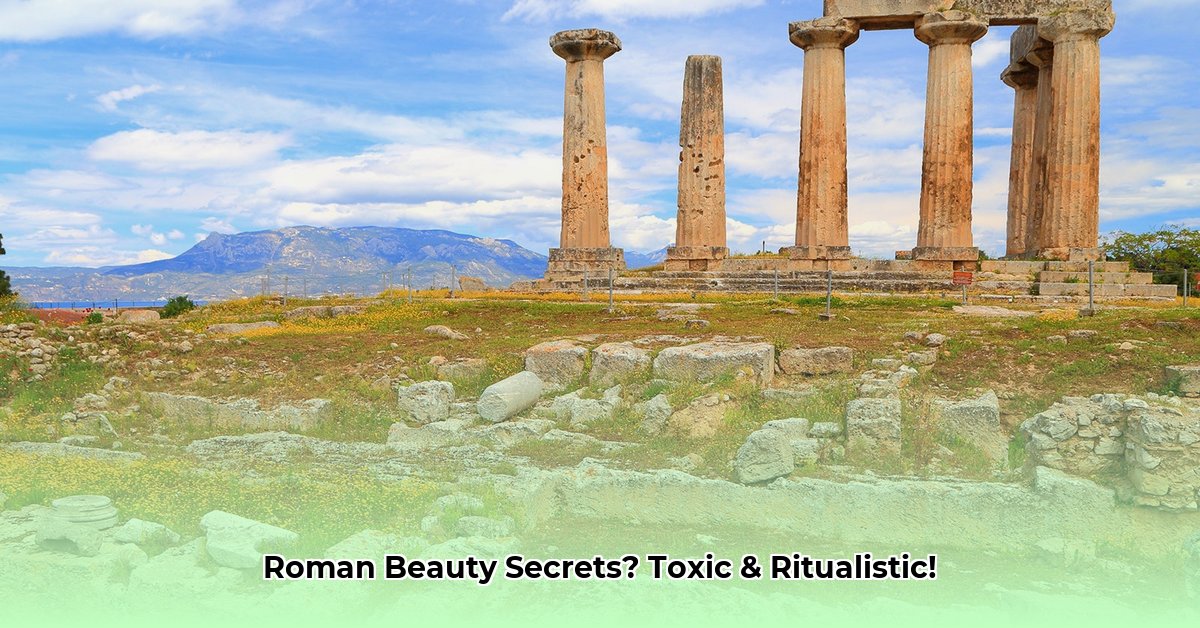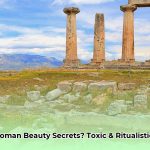Ever wondered how the elite and everyday citizens of ancient Rome perfected their appearance? Forget modern beauty counters; their routines involved a fascinating, often perilous, blend of natural ingredients, imported luxuries, and surprisingly potent substances. From desire for luminous pale skin to dramatic eye makeup and elaborate hairstyles, Roman beauty practices were far more than mere vanity—they were intricate expressions of social status, personal identity, and sometimes, a defiance of societal judgment. Dive into the complex, captivating world of ancient Roman cosmetics, exploring the surprising ingredients, ritualistic applications, and the enduring legacy of a society deeply engrossed in the art of adornment. Want to learn about Roman hairstyles used?
Pivotal Insights into Roman Beauty:
- The relentless pursuit of beauty in ancient Rome frequently involved hazardous ingredients like white lead, posing significant health risks despite known dangers.
- Cosmetic choices and elaborate hairstyles served as crucial indicators of an individual’s social status, wealth, and moral standing.
- Roman society grappled with conflicting views on cosmetic use, navigating the fine line between personal expression, perceived moral decay, and even medicinal belief.
- Archaeological discoveries, alongside literary accounts, offer a comprehensive understanding of Roman beauty rituals, revealing sophisticated techniques and tools.
The Allure of Pallor: Skin Whitening and Skincare Rituals
In ancient Rome, a pristine, pale complexion was the ultimate signifier of aristocracy and leisure. It conveyed that a woman was wealthy enough to avoid manual labor under the sun, demonstrating a life lived indoors, attended by slaves. This ideal drove women to extraordinary and often dangerous lengths to achieve luminosity. They applied concoctions rich in chalk powder, white marl, and even crocodile dung. Alarmingly, the most sought-after and widely used whitening agent was white lead (cerussa), a potent neurotoxin. Despite widespread knowledge of its poisonous nature, its use underscored the profound societal pressure to conform to this beauty ideal, often outweighing known health risks and causing lead poisoning, organ damage, and other debilitating ailments.
Beyond whitening, Roman women invested heavily in skincare. They used pre-makeup beauty masks, with recipes calling for ingredients ranging from lanolin (sweat from sheep’s wool) to more astonishing components like animal urine, sulfur, vinegar, bile, and even placenta. More appealing options included honey, rosewater, olive oil, and various plant extracts. For anti-aging, swans’ fat and asses’ milk were popular—the latter notably used by wealthy figures such as Cleopatra VII and Poppaea Sabina for its lactic acid exfoliating properties. Wrinkles were softened with bean-meal, while blemishes were often concealed with soft leather patches of alum, sometimes shaped like crescents, which criminals and freedmen also used to hide brand marks.
Defining the Gaze: Eye Makeup and its Dual Purpose
Roman beauty ideals emphasized large, expressive eyes framed by long lashes and darkened eyebrows that often met at the bridge of the nose, creating a “doe-like” appearance. Women meticulously applied kohl—a black powder derived from substances such as soot, antimony, or galena—to darken their eyelashes and eyebrows. This wasn’t merely cosmetic; pharmacological studies confirm that galena-based kohl stimulated nitric oxide production, enhancing immune response and offering antibacterial protection against strains like Staphylococcus aureus. This medicinal benefit, protecting against eye infections, explains its widespread adoption and Pliny the Elder’s description of stibium (antimony or galena) as an “eye medication.”
Kohl was typically applied with slender applicators made from wood, glass, bone, or ivory, often moistened with water or perfumed oil. Cylindrical kohl containers, sometimes with multiple compartments, held different pigments, including popular green from malachite and blue from azurite. These vibrant colors signaled wealth, as the pigments were expensive. Other eye-darkening methods included burnt cork, charred rose petals, and date stones. Beyond kohl, a cosmetic called calliblepharum, possibly made from the ash of rose kernels or asphalt, was also used to tint eyelashes or eyelids.
Class distinctions influenced choices: wealthier women favored expensive minerals like antimony and galena, while lower-class women relied on accessible soot from oil lamps. Despite male authors’ disdain for cosmetics—Juvenal mocked women’s extensive routines, and Clement of Alexandria criticized the use of soot as “crocodile excrement”—mummy portraits from Roman Egypt visually confirm the prevalence of defined eyes, reflecting these beauty standards.
Hair as a Canvas: Styles, Dyes, and Depilation
Hair played a paramount role in ancient Roman society, with elaborate styles serving as direct indicators of social status, wealth, and sophistication. Affluent women employed professional hairstylists known as ornatrices, and even slaves, to craft towering, intricate styles featuring curls, braids, and buns. These complex updos, often achieved with bronze rods heated on hot ashes (calamistrum), were visual testaments to the wearer’s status. The motto was often “more was more,” contrasting with the “natural” styles associated with barbarians.
Blond and red hair were highly fashionable. Dyes were concocted from mixtures like saffron, beech ash, goat fat, and even fermented leeches for desired shades. For black hair, cypress leaves brewed with vinegar and absinthe ash mixed with rose oil were used. Wigs and hair extensions, made from real hair (blonde from Northern Europe, black from India), were exceptionally popular among the elite, flaunting wealth and connections.
Body hair, with the exception of head hair, was considered unattractive. Roman women practiced extensive depilation through various methods: shaving with bronze razors, plucking with tweezers, stripping with resin paste, or scraping with pumice stones. Arsenic was sometimes used in depilatory creams, highlighting the extreme measures taken for smooth skin, which was also seen as preparation for sex, subjecting older women to ridicule for the practice.
The Scent of Status: Perfumes, Oral Hygiene, and Accessories
Perfumes in ancient Rome were far more than just pleasant scents; they were potent statements of status, effective maskers of unpleasant odors (especially from poorly composed cosmetics), and integral to religious ceremonies. Available in liquid, solid, and sticky forms, they were created through a maceration process involving flowers, herbs, and oils, often with ingredients imported from the East. The most prominent perfume market in Italy was Seplasia in Capua. Deodorants made from alum, iris, and rose petals were also common. Interestingly, different scents were appropriate for different occasions and for men and women. However, the widespread embrace of perfume was not universal; figures like Cicero criticized its excessive use as a sign of moral decay.
While oral hygiene standards differ vastly from today’s, white teeth were highly prized. False teeth, crafted from bone, ivory, and paste, were popular. Ovid highlighted the societal view, stating, “You can do yourself untold damage when you laugh if your teeth are black, too long or irregular.” Romans also sweetened their breath with powder and baking soda. Nail care was also a mark of status; typically, only the wealthy had their nails clipped short by barbers, following current hygiene practices.
Cosmetics and perfumes were sold at marketplaces, often in tablet or cake form. Wealthy women bought expensive makeup in elaborate containers made from gold, wood, glass, or bone. Glassblowing, invented in 1st century CE Syria, later lowered container prices. Mirrors, mostly hand mirrors made from polished metal or mercury behind glass, were common tools. A peculiar aspect of Roman beauty culture involved the sale of gladiator sweat and animal fats from the arena in souvenir pots, believed to improve complexion.
Social Ambivalence: Beauty Versus Morality
Roman society harbored deeply divided opinions concerning cosmetics. While some embraced makeup as a form of artistic self-expression and an enhancement of natural beauty, a powerful segment, particularly male authors and philosophers, vehemently condemned it as deceitful and morally corrupt. Juvenal wrote that “a woman buys scents and lotions with adultery in mind,” and Seneca advised virtuous women to avoid cosmetics, believing their use contributed to Rome’s moral decline. The Latin word lenocinium even meant both “prostitution” and “makeup,” highlighting the association of cosmetics with immorality, especially for prostitutes who used cheaper, foul-smelling varieties and more copious amounts as they aged.
Men were not exempt from this scrutiny. While moderate perfume use and hair removal were acceptable, men seen carrying mirrors or using face-whitening makeup were viewed as effeminate and immoral. Emperors like Otho and Elagabalus, known for their vanity and cosmetic use, caused public grief. Despite these criticisms, Ovid stood out in his approval, writing in Medicamina Faciei Femineae, “Let each girl enhance her beauty as best she can: art, too, is a part of beauty,” viewing cosmetics as a source of pleasure and a tool for women to express individuality in a society with limited female liberty.
Archaeological Evidence: Unearthing Ancient Beauty Secrets
Archaeological excavations have yielded a rich trove of cosmetic containers (unguentaria), applicators, mirrors, and various other artifacts, providing invaluable insights into the daily lives and beauty rituals of Romans. Chemical analysis of cosmetic residues within these containers offers precise data on the ingredients used, illuminating the composition of ancient Roman beauty products. For instance, the “Londinium cream,” found in London, was analyzed to consist of animal fat, starch, and tin. Modern non-invasive techniques like synchrotron radiation and mass spectrometry are now used to analyze fragile artifacts.
These tangible discoveries, coupled with preserved written sources, paint a clearer picture of how beauty practices intertwined with wider Roman society. Visual representations in art, such as wall paintings and funerary reliefs, frequently depict toilette scenes and beauty tools, alluding to wealth and status. Moreover, meticulously preserved mummy portraits from Roman Egypt vividly showcase women adorned with defined eyes and lashes, reinforcing our understanding of prevailing beauty standards in Roman antiquity. Ongoing excavations consistently promise to unearth even more secrets, enriching our comprehension of this ancient civilization’s commitment to aesthetic presentation.
Lessons from the Ancients: A Cautionary and Inspiring Tale
The beauty secrets of ancient Rome unveil a complex interplay of social status, gender expectations, and deeply ingrained cultural values. While some of their cosmetic practices appear bizarre or even dangerous by contemporary standards, they offer a profound understanding of the lives of Roman individuals who endeavored to enhance their appearance—often at great personal cost.
The inherent human desire to look and feel beautiful transcends time and culture. However, the legacy of ancient Rome serves as a poignant reminder to be highly mindful of the ingredients we apply to our bodies and to critically assess the societal pressures we face in the pursuit of aesthetic perfection. While some ancient natural ingredients might inspire modern formulations, the definitive cautionary tale lies in the dangers of unregulated and toxic chemicals. The Roman pursuit of beauty, with its blend of innovation and extravagance, continues to intrigue and inspire, offering a window into the timeless human desire to adorn and enhance our appearance.
References:
- Olson, K. (2009). Cosmetics in Roman Antiquity: Substance, Remedy, Poison. Palgrave Macmillan.
- Wikimedia Foundation. (n.d.). Cosmetics in ancient Rome. Wikipedia. Retrieved from https://en.m.wikipedia.org/wiki/Cosmetics_in_Ancient_Rome
- Blakemore, E. (2015, December 22). This Woman Is a Hair Style Archaeologist. Smithsonian Magazine. Retrieved from https://www.smithsonianmag.com/smart-news/this-woman-is-a-hair-style-archaeologist-82478448/










